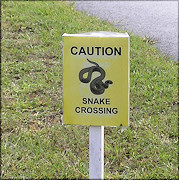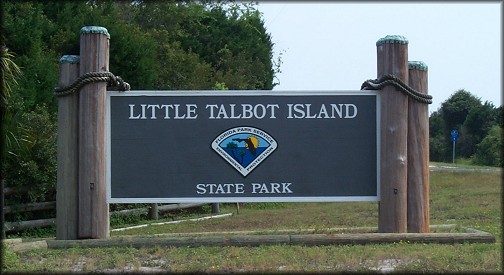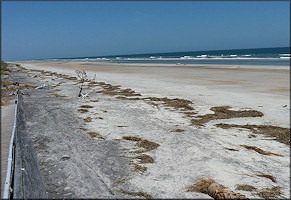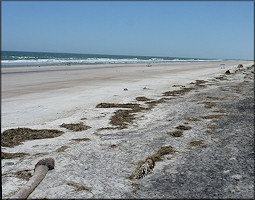| Little Talbot Island State Park - Ft. George, Florida | |
| ((click on the pictures for a higher resolution version)) | |
| Located twenty miles from downtown Jacksonville, Little Talbot Island is one of the few remaining undeveloped, barrier islands in Northeast Florida. The entire island, 2,500 acres, is a State Park. The park has more than 5 miles of beautiful, wide sandy beaches, undisturbed salt marshes, and vegetated dunes. Florida State Parks are managed as natural systems. All plant and animal life is protected. Do not remove, deface, mutilate or molest any natural resources. | |
|
|
|
 Discussion: Bounded on the south by the
Ft. George Inlet and on the west by the
Fort
George River and
Simpson Creek, Little Talbot
Island is truly a barrier island on the move. The southern portion of
the island is moving northward as the Ft. George River channel
has changed from an easterly course to a northeasterly course thus
eroding the bottom half of the island. Likewise, the Ft. George River
has severely eroded the islands western side - roughly doubling the size
of the river bottom and necessitating the replacement of the Ft. George River
Bridge
(August, 2003) with a more substantial structure. If you
crave solitude, this is the beach to visit. Even during the
busiest weekend days of summer, one can easily find a strand where
another human will not be seen. During the cooler months, you will
likely have all five miles of beach to yourself. Discussion: Bounded on the south by the
Ft. George Inlet and on the west by the
Fort
George River and
Simpson Creek, Little Talbot
Island is truly a barrier island on the move. The southern portion of
the island is moving northward as the Ft. George River channel
has changed from an easterly course to a northeasterly course thus
eroding the bottom half of the island. Likewise, the Ft. George River
has severely eroded the islands western side - roughly doubling the size
of the river bottom and necessitating the replacement of the Ft. George River
Bridge
(August, 2003) with a more substantial structure. If you
crave solitude, this is the beach to visit. Even during the
busiest weekend days of summer, one can easily find a strand where
another human will not be seen. During the cooler months, you will
likely have all five miles of beach to yourself. |
|
|
Little Talbot Island Beach Looking To The Northeast |
Little Talbot Island Beach Looking To The South |
| Shelling: As with most Northeast Florida Beaches, both live and dead mollusks are not particularly common throughout most of the year. The best shelling area is from the first beach walk-over access point, near the ranger station, southward to the Ft. George Inlet (about 1.8 miles). This area appears to be especially productive due to the converging currents. Shelling this area 2-3 days after a "northeaster" or other similar rough seas, can yield an amazing selection of northeast Florida mollusks. During a similar scenario during 2001, 159 Epitonium (four species) were found on a 100 foot stretch of beach. Northeast Florida in general, and Little Talbot Island in particular, is not known for its fossil marine mollusks. However, on rare occasions an unusual specimen such as a Pliocene Ecphora quadricostata (Say, 1824) "Four-ridged Ecphora" may be found. | |
|
Little Talbot Island Beach At Low Tide On 10/17/2013 |
|
History Of The Talbot Islands - 6,000 Years Of Human Habitation |


